Denis Papin
Denis Papin FRS (French pronunciation: [dəni papɛ̃]; 22 August 1647 – 26 August 1713)[1] was a French physicist, mathematician and inventor, best known for his pioneering invention of the steam digester, the forerunner of the pressure cooker and of the steam engine.[2][3]
Denis Papin | |
|---|---|
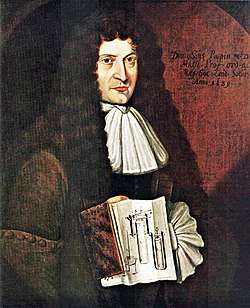 Denis Papin, unknown artist, 1689. | |
| Born | August 22, 1647 |
| Died | August 26, 1713 (aged 66) |
| Nationality | French |
| Known for | Steam digester |
Life in France
Born in Chitenay (Loir-et-Cher, Centre-Val de Loire Région), Papin attended a Jesuit school there, and from 1661 attended University at Angers, from which he graduated with a medical degree in 1669. In 1673, while working with Christiaan Huygens and Gottfried Leibniz in Paris, he became interested in using a vacuum to generate motive power.
First visit to London
Papin first visited London in 1675, and worked with Robert Boyle from 1676 to 1679, publishing an account of his work in Continuation of New Experiments (1680).[4] During this period, Papin invented the steam digester, a type of pressure cooker with a safety valve. He first addressed the Royal Society in 1679 on the subject of his digester, and remained mostly in London until about 1687, when he left to take up an academic post in Germany.
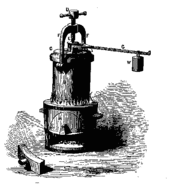 Denis Papin's steam digester (1679)
Denis Papin's steam digester (1679)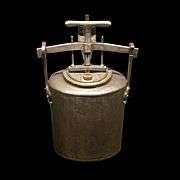 A "Papin" cooking pot, late 18th century
A "Papin" cooking pot, late 18th century
Germany
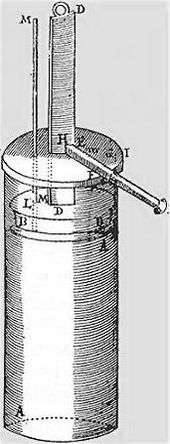
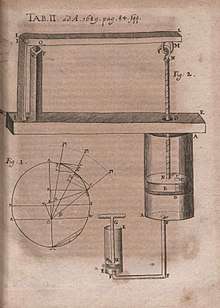
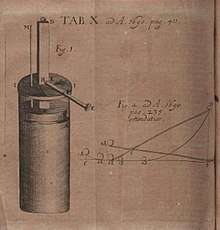
As a Huguenot, Papin found himself greatly affected by the increasing restrictions placed on Protestants by Louis XIV of France and by the King's ultimate revocation of the Edict of Nantes in 1685. In Germany he was able to live with fellow Huguenot exiles from France.
In 1689, Papin suggested that a force pump or bellows could maintain the pressure and fresh air inside a diving bell. (Engineer John Smeaton utilised this design in 1789.[5][6])
While in Marburg in 1690, having observed the mechanical power of atmospheric pressure on his 'digester', Papin built a model of a piston steam engine, the first of its kind.
Papin continued to work on steam engines for the next fifteen years. In 1695 he moved from Marburg to Kassel. In 1705 he developed a second steam engine with the help of Gottfried Leibniz, based on an invention by Thomas Savery, but this used steam pressure rather than atmospheric pressure. Details of the engine were published in 1707.
During his stay in Kassel in Hesse, in 1704, he constructed a ship powered by his steam engine, mechanically linked to paddles. This made him the first to construct a steam-powered boat (or vehicle of any kind). Later, at the iron foundry in Veckerhagen (now Reinhardshagen), he cast the world's first steam cylinder.
Return to London
Papin returned to London in 1707, leaving his wife in Germany. Several of his papers were put before the Royal Society between 1707 and 1712 without acknowledging or paying him, about which he complained bitterly. Papin's ideas included a description of his 1690 atmospheric steam engine, similar to that built and put into use by Thomas Newcomen in 1712, thought to be the year of Papin's death.
The last surviving evidence of Papin's whereabouts came in a letter he wrote dated 23 January 1712. At the time he was destitute ("I am in a sad case") [Royal Society Archives, 1894, Vol. 7, 74], and it is believed he died that year and was buried in an unmarked grave in London.
A record exists for the burial of a “Denys Papin” in an 18th-century Register of Marriages & Burials[7] which originally came from St Bride's Church, Fleet Street, London, but which is now stored in the London Metropolitan Archives. The record states that Denys Papin was buried at St Bride's on 26 August 1713 – just a few days after his 66th birthday – and that he was laid to rest in the Lower Ground, one of the two burial areas belonging to the church at the time.
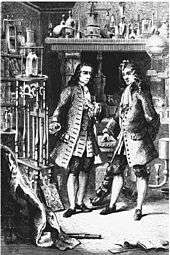 Robert Boyle and Denis Papin inspecting Papin's digester
Robert Boyle and Denis Papin inspecting Papin's digester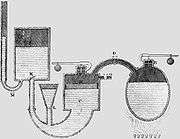 Second Papin steam engine, 1707
Second Papin steam engine, 1707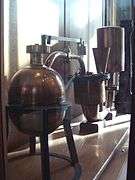 Steam-driven water-lifting machine by Papin in 1707, reconstruction, from Nouvelle manière d'élever l'eau par la force du feu. Musée des Arts et Métiers
Steam-driven water-lifting machine by Papin in 1707, reconstruction, from Nouvelle manière d'élever l'eau par la force du feu. Musée des Arts et Métiers
Legacy
Boulevard Denis Papin in Carcassonne is named after him. There is also a statue of Papin with his invention in Blois, at the top of the Escalier Denis Papin, a stairway.
Works
- Nouvelle manière pour lever l'eau par la force du feu ... par m. D. Papin. A Cassel: pour Jacob Estienne libraire de la cour : par Jean Gaspard Voguel imprimeur. 1707.
 Nouvelle manière pour lever l'eau par la force du feu (1707)
Nouvelle manière pour lever l'eau par la force du feu (1707)
References
- Excerpt from St Bride's Register Marriages Burrials
- Hindle, Brooke; Lubar, Steven (1986). Engines of Change: The American Industrial Revolution 1790-1860. Washington, DC and London: Smithsonian Institution Press. ISBN 0-87474-540-3.
- Acta Eruditorum. Leipzig. 1689. p. 96.
- Anita McConnell, 'Papin, Denis (1647–1712?)', Oxford Dictionary of National Biography, Oxford University Press, 2004, accessed 29 April 2006]
- Davis, RH (1955). Deep Diving and Submarine Operations (6th ed.). Tolworth, Surbiton, Surrey: Siebe Gorman & Company Ltd. p. 693.
- Acott, C. (1999). "A brief history of diving and decompression illness". South Pacific Underwater Medicine Society Journal. 29 (2). ISSN 0813-1988. OCLC 16986801. Retrieved 17 March 2009.
- London Metropolitan Archives; Collection: Saint Bride; Title: “Register of Marriages Burrials &tc from 1695 to Aug 1714”; catalogue reference: P69/BRI/A/01/Ms6540/3. (seen June 2016)
External links


- O'Connor, John J.; Robertson, Edmund F., "Denis Papin", MacTutor History of Mathematics archive, University of St Andrews.

- Works by Denis Papin at Project Gutenberg
- Works by Denis Papin at Open Library